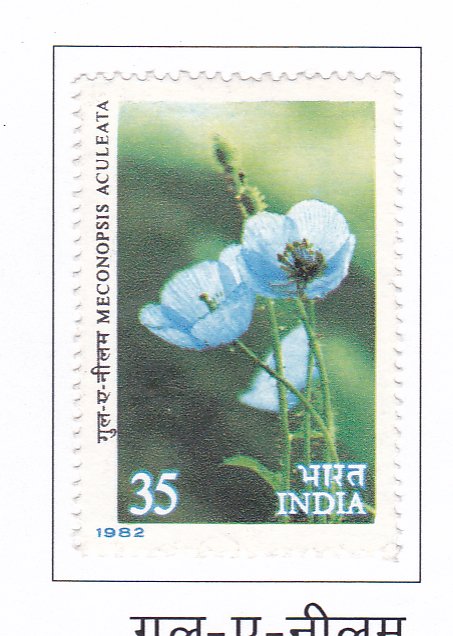Blue Poppy (Meconopsis aculeata)

Technical Data
| Stamp Set | Indian Flowers |
|---|---|
| Date of Issue | May 29, 1982 |
| Denomination | 35 p |
| Quantity | 3,000,000 |
| Perforation | comb 14 |
| Printer | Security Printing Press, Nashik |
| Watermark | No Watermark |
| Colors | Multicolor |
| Catalog Codes |
Michel IN 908 Stamp Number IN 959 Yvert et Tellier IN 709 Stanley Gibbons IN 1043 |
| Themes | Flowers | Plants (Flora) |
The narrative of the Himalayas, with their majestic peaks and stunning vistas, is as mesmerizing as the origin of this imposing mountain range. Over 200 million years ago, during the era of Pangea, the Earth’s landmasses were connected as one. However, the movement of sub-surface basaltic rock-plates led to the separation of these landmasses, forming the continents we recognize today. Amidst this geological ballet, India embarked on a remarkable journey. Once near the present-day Malagasy Republic, India undertook a swift northeastward trajectory, colliding with Asia to create the Himalayas, the world’s youngest and most imposing mountain range.
The Himalayas, with their snow-capped peaks reaching towards the heavens, have inspired saints, seers, poets, and artists for millennia. As the range rose ever higher, it provided a sanctuary for a diverse array of flora, making the Himalayan region one of the richest botanical landscapes on Earth. According to J.D. Hooker, an esteemed botanist, the Himalayas boast over 3,100 plant species spanning more than 1,100 genera, thriving at elevations ranging from 1,800 to over 5,000 meters.
Among this botanical tapestry, the Indian Posts and Telegraphs Departments have selected four flowers of exceptional rarity and beauty:
- Meconopsis Aculeata (Blue Poppy; Gul-e-nilam, Kanta): This rare ornamental graces alpine meadows and rocky slopes with its exquisite blue and purple hues, contrasting beautifully with the snowy backdrop. Found at elevations of 3,000 to 4,500 meters, its slender-pedicelled flowers and golden-yellow stamens captivate all who behold them.
- Inula Grandiflora (Showy Inula; Poshkar, Rasan, Zanjabil-i-shami): Adorning the Himalayan landscape with its orange-yellow blooms, this stout perennial herb exudes an aromatic charm. With leaves ranging from elliptic-oblong to subcordate, it stands tall at altitudes of 1,800 to 3,600 meters, a testament to nature’s artistry.
- Arisaema Wallachianum (Cobra Lily; Arisaemapropinquum Schott): Named for its hood-like spathe reminiscent of a cobra’s hood, this member of the Aroid Family adds intrigue to the Himalayan flora. With its solitary leaves and showy berries, it thrives at altitudes of 1,800 to 4,270 meters, enchanting all who encounter it.
- Saussurea Obvallata (Brahma kamal): Symbolizing resilience and beauty at high altitudes, this sacred species blooms amidst the icy terrain of the Himalayas. With its purple or bluish flowers nestled within membranous trusses, it flourishes at elevations of 3,000 to 4,600 meters, offering a glimpse of ethereal beauty in the mountain wilderness.
These four Himalayan flowers, chosen for their rarity and pristine charm, serve as ambassadors of the region’s unparalleled biodiversity and natural splendor.
(Text adapted from material courtesy of S.N. Tata and T.C.S. Sastry).
